Have you ever wondered how to do live voice-to-text transcription with Python? We'll use Django and Deepgram to achieve our goal in this article.
Django is a familiar Python web framework for rapid development. It provides a lot of things we need "out of the box" and everything is included with the framework, following a “Batteries included” philosophy. Deepgram uses AI speech recognition to do real-time audio transcription, and we’ll be using our Python SDK.
The final code for this project is here in Github if you want to jump ahead.
Getting Started
Before we start, it’s essential to generate a Deepgram API key to use in our project. We can go here. For this tutorial, we'll be using Python 3.10, but Deepgram supports some earlier versions of Python as well. We're also going to use Django version 4.0 and Django Channels to handle the WebSockets. We'll need to set up a virtual environment to hold our project. We can read more about those here and how to create one.
Install Dependencies
Create a folder directory to store all of our project files, and inside of it, create a virtual environment. Ensure our virtual environment is activated, as described in the article in the previous section. Make sure that all of the dependencies get installed inside that environment.
For a quick reference, here are the commands we need to create and activate our virtual environment:
mkdir [% NAME_OF_YOUR_DIRECTORY %]
cd [% NAME_OF_YOUR_DIRECTORY %]
python3 -m venv venv
source venv/bin/activateWe need to install the following dependencies from our terminal:
The latest version of Django
The Deepgram Python SDK
The dotenv library, which helps us work with our environment variables
The latest version of Django Channels
pip install Django
pip install deepgram-sdk
pip install python-dotenv
pip install channelsCreate a Django Project
Let's get a Django project created by running this command from our terminal, django-admin startproject stream.
Our project directory will now look like this:
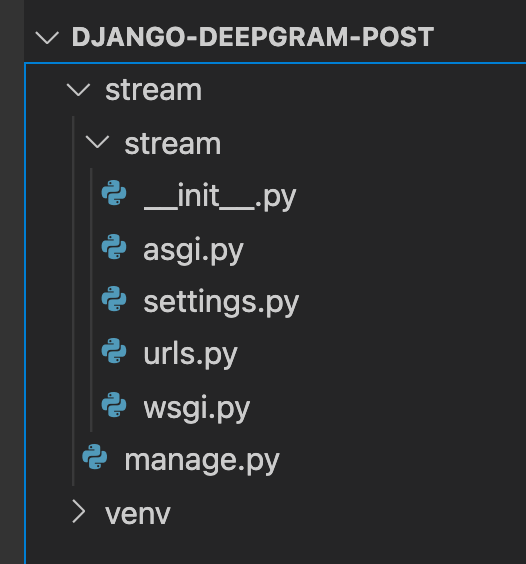
Create a Django App
We need to hold our code for the server part of our application inside an app called transcript. Let’s ensure we’re inside our project with manage.py. We need to change directories into our stream project by doing the following:
cd stream
python3 manage.py startapp transcriptWe’ll see our new app transcript at the same directory level as our project.
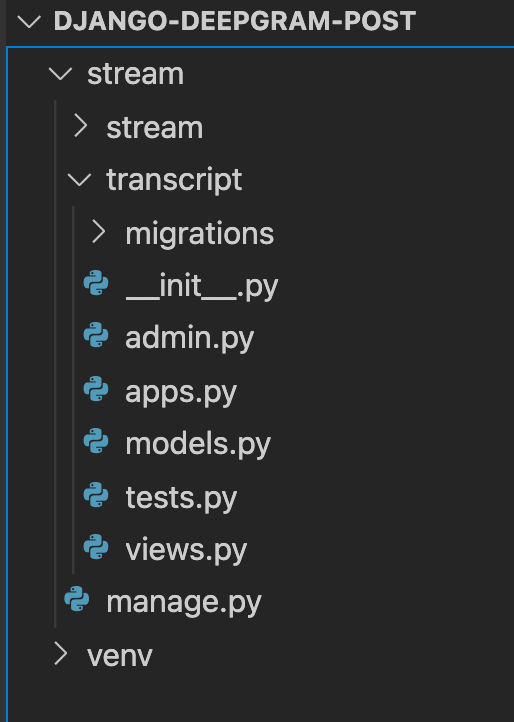
We also need to tell our project that we’re using this new transcript app. To do so, go to our stream folder inside our settings.py file and add our app to INSTALLED_APPS.

Create Index View
Let’s get a starter Django application up and running that renders an HTML page so that we can progress on our live transcription project.
Create a folder called templates inside our transcript app. Inside the templates folder, create an index.html file inside another directory called transcript.
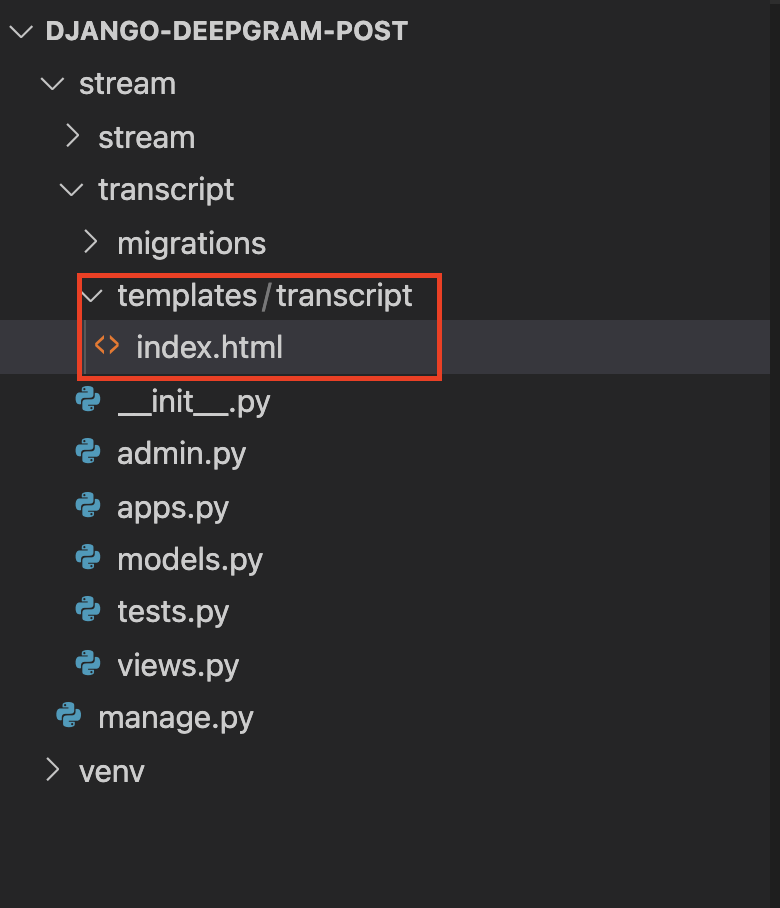
Inside our transcript/templates/transcript/index.html add the following HTML markup:
<!DOCTYPE html>
<html>
<head>
<title>Live Transcription</title>
</head>
<body>
<h1>Transcribe Audio With Django</h1>
<p id="status">Connection status will go here</p>
<p id="transcript"></p>
</body>
</html>Then add the following code to our views.py and transcript app.
from django.shortcuts import render
def index(request):
return render(request, 'transcript/index.html')We need to create a urls.py inside our transcript app to call our view.
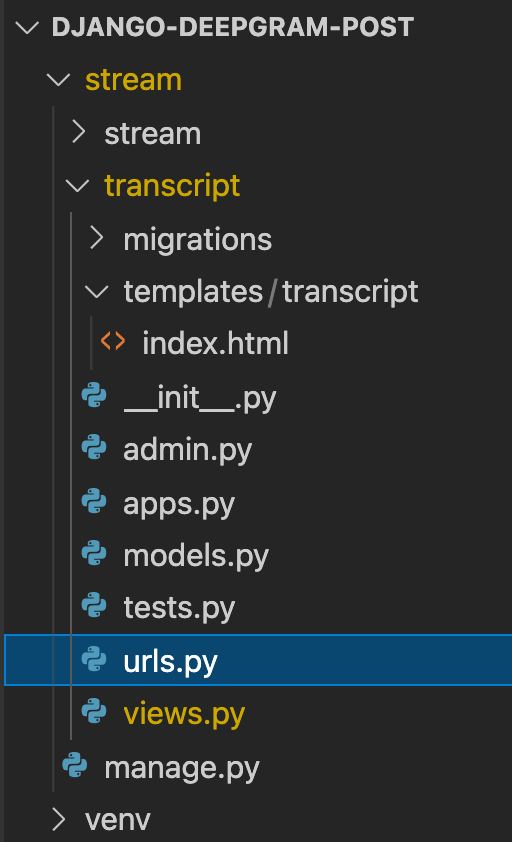
Let’s add the following code to our new urls.py file:
from django.urls import path
from . import views
urlpatterns = [
path('', views.index, name='index'),
]We have to point this file at the transcript.urls module to stream/urls.py. In the stream/urls.py add the code:
from django.conf.urls import include
from django.contrib import admin
from django.urls import path
urlpatterns = [
path('', include('transcript.urls')),
path('admin/', admin.site.urls),
]If we start our development server from the terminal to run the project using python3 manage.py runserver, the index.html page renders in the browser when we navigate to our localhost at http://127.0.0.1:8000.
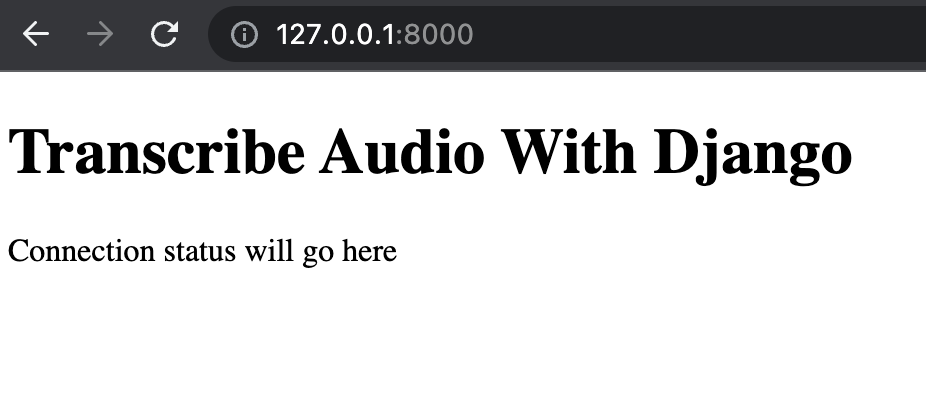
Integrate Django Channels
We need to add code to our stream/asgi.py file.
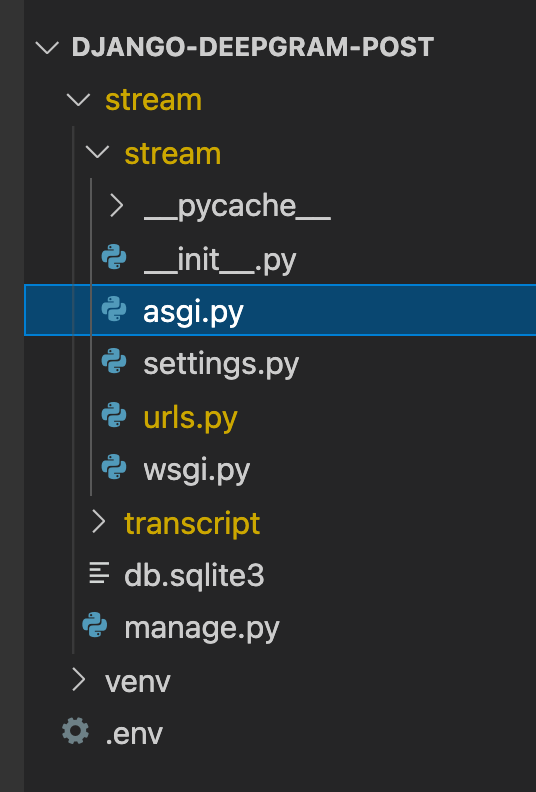
import os
from channels.auth import AuthMiddlewareStack
from channels.routing import ProtocolTypeRouter, URLRouter
from django.core.asgi import get_asgi_application
import transcript.routing
os.environ.setdefault("DJANGO_SETTINGS_MODULE", "stream.settings")
application = ProtocolTypeRouter({
"http": get_asgi_application(),
"websocket": AuthMiddlewareStack(
URLRouter(
transcript.routing.websocket_urlpatterns
)
),
})Now we have to add the Channels library to our INSTALLED_APPS in the settings.py file at stream/settings.py
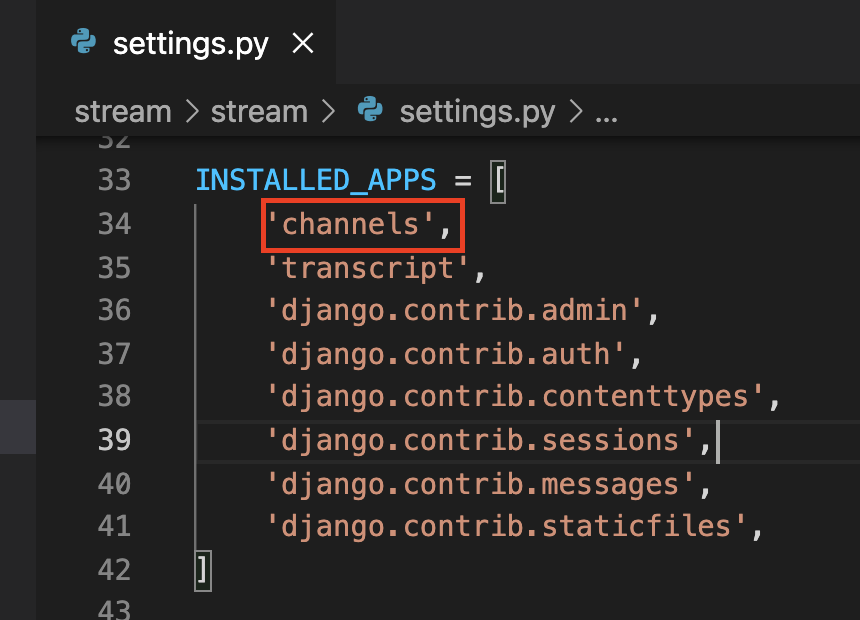
We also need to add the following line to our stream/settings.py at the bottom of the file:
ASGI_APPLICATION = 'stream.asgi.application'
To ensure everything is working correctly with Channels, run the development server python3 manage.py runserver. We should see the output in our terminal like the following:

Add Deepgram API Key
Our API Key will allow access to use Deepgram. Let’s create a .env file that will store our key. When we push our code to Github, hide our key, make sure to add this to our .gitignore file.
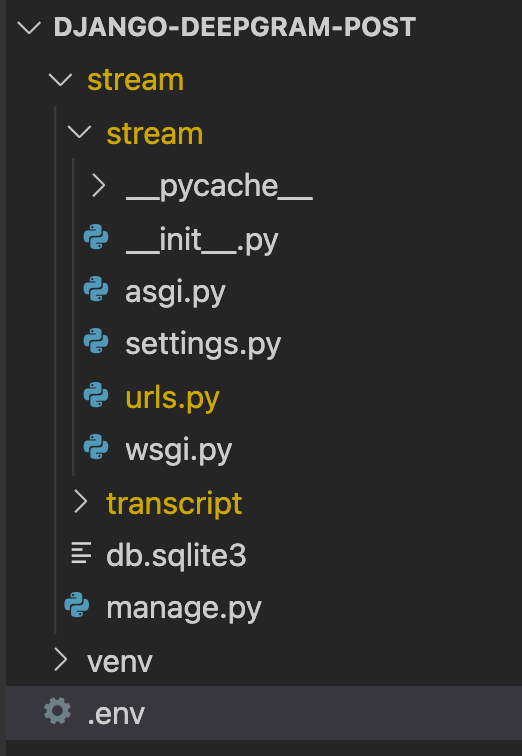
In our file, add the following environment variable with our Deepgram API key, which we can grab here:
DEEPGRAM_API_KEY="abcde12345"Next, create a consumers.py file inside our transcript app, acting as our server.
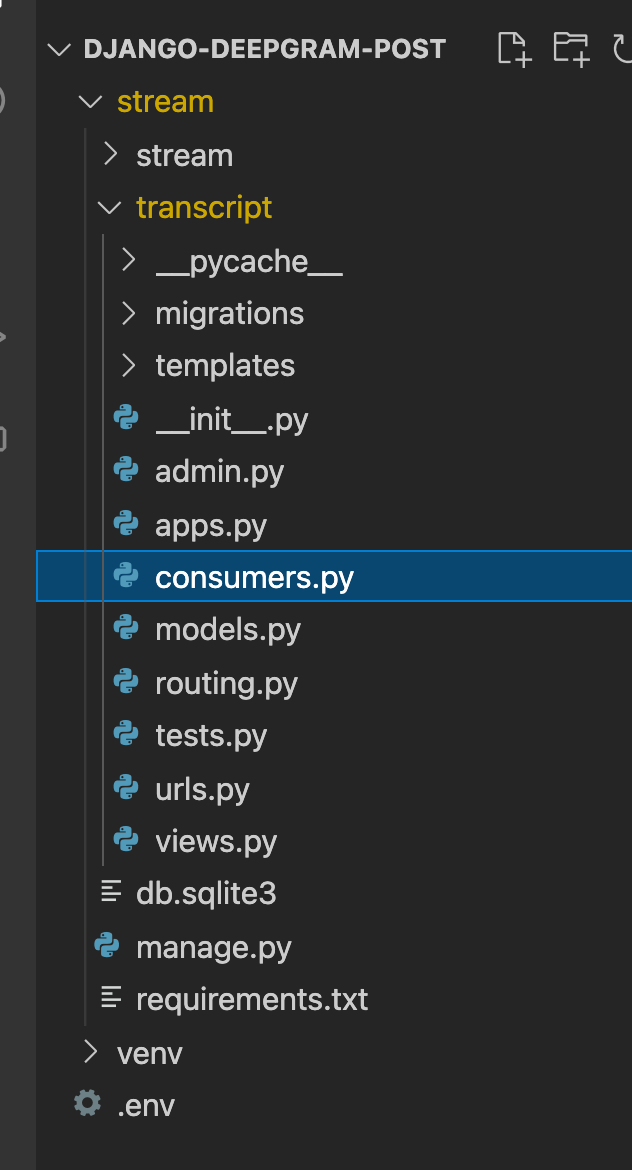
Let’s add this code to our consumers.py. This code loads our key into the project and accesses it in our application:
from channels.generic.websocket import AsyncWebsocketConsumer
from dotenv import load_dotenv
from deepgram import Deepgram
import os
load_dotenv()
class TranscriptConsumer(AsyncWebsocketConsumer):
dg_client = Deepgram(os.getenv('DEEPGRAM_API_KEY'))We also have to add a routing.py file inside our transcript app. This file will direct channels to run the correct code when we make an HTTP request intercepted by the Channels server.
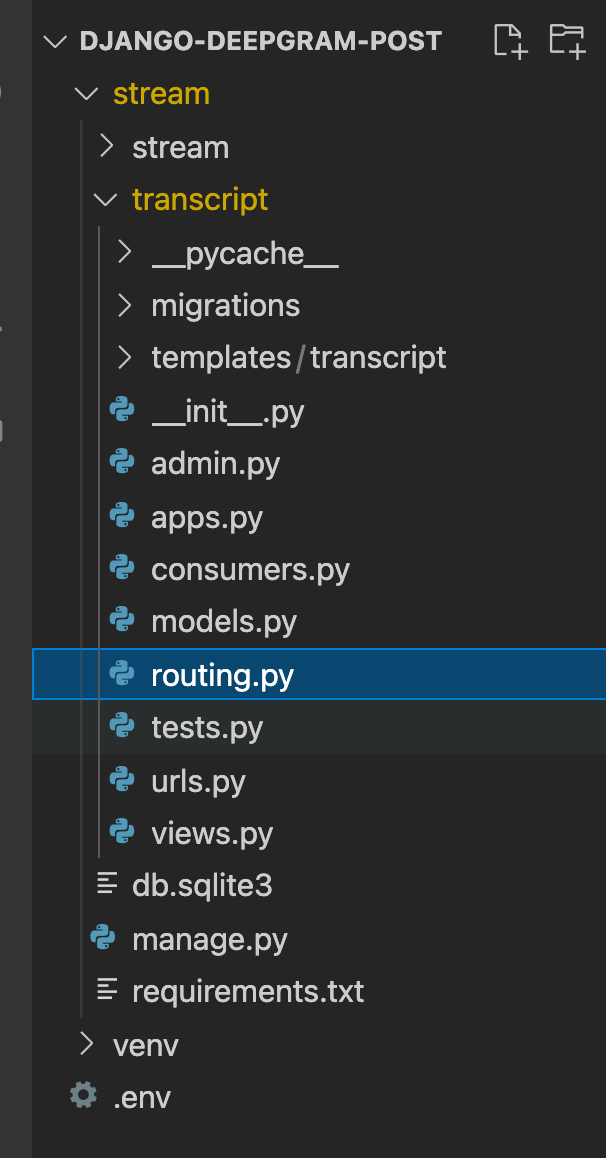
from django.urls import re_path
from . import consumers
websocket_urlpatterns = [
re_path(r'listen', consumers.TranscriptConsumer.as_asgi()),
]Get Mic Data From Browser
Our next step is to get the microphone data from the browser, which will require a little JavaScript.
Use this code inside the <script></script> tag in index.html to access data from the user’s microphone.
<script>
navigator.mediaDevices.getUserMedia({ audio: true }).then((stream) => {
const mediaRecorder = new MediaRecorder(stream)
})
</script>If you want to learn more about working with the mic in the browser, please check out this post.
Websocket Connection Between Server and Browser
We’ll need to work with WebSockets in our project. We can think of WebSockets as a connection between a server and a client that stays open and allows sending continuous messages back and forth.
The first WebSocket connection is between our Python server that holds our Django application and our browser client. In this project, we’ll use Django Channels to handle the WebSocket server.
We need to create a WebSocket endpoint that listens to our Django web server code for client connections. In the consumers.py file from the previous section re_path(r'listen', consumers.TranscriptConsumer.as_asgi()) accomplishes this connection.
class TranscriptConsumer(AsyncWebsocketConsumer):
dg_client = Deepgram(os.getenv('DEEPGRAM_API_KEY'))
async def connect(self):
await self.connect_to_deepgram()
await self.accept()
async def receive(self, bytes_data):
self.socket.send(bytes_data)The above code accepts a WebSocket connection between the server and the client. As long as the connection stays open, we will receive bytes and wait until we get a message from the client. While the server and browser connection remains open, we’ll wait for messages and send data.
In index.html, this code listens for a client connection then connects to the client like so:
<script>... const socket = new WebSocket('ws://localhost:8000/listen')</script>Websocket Connection Between Server and Deepgram
We need to establish a connection between our central Django server and Deepgram to get the audio and real-time transcription. Add this code to our consumers.py file.
from typing import Dict
class TranscriptConsumer(AsyncWebsocketConsumer):
dg_client = Deepgram(os.getenv('DEEPGRAM_API_KEY'))
async def get_transcript(self, data: Dict) -> None:
if 'channel' in data:
transcript = data['channel']['alternatives'][0]['transcript']
if transcript:
await self.send(transcript)
async def connect_to_deepgram(self):
try:
self.socket = await self.dg_client.transcription.live({'punctuate': True, 'interim_results': False})
self.socket.registerHandler(self.socket.event.CLOSE, lambda c: print(f'Connection closed with code {c}.'))
self.socket.registerHandler(self.socket.event.TRANSCRIPT_RECEIVED, self.get_transcript)
except Exception as e:
raise Exception(f'Could not open socket: {e}')
async def connect(self):
await self.connect_to_deepgram()
await self.accept()
async def disconnect(self, close_code):
await self.channel_layer.group_discard(
self.room_group_name,
self.channel_name
)
async def receive(self, bytes_data):
self.socket.send(bytes_data)The connect_to_deepgram function connects us to Deepgram and creates a socket connection to deepgram, listens for the connection to close, and gets incoming transcription objects. The get_transcript method gets the transcript from Deepgram and sends it back to the client.
Lastly, in our index.html, we need to receive and obtain data with the below events. Notice they are getting logged to our console. If you want to know more about what these events do, check out this blog post.
<script>
socket.onopen = () => {
document.querySelector('#status').textContent = 'Connected'
console.log({
event: 'onopen'
})
mediaRecorder.addEventListener('dataavailable', async (event) => {
if (event.data.size > 0 && socket.readyState == 1) {
socket.send(event.data)
}
})
mediaRecorder.start(250)
}
socket.onmessage = (message) => {
const received = message.data
if (received) {
console.log(received)
document.querySelector('#transcript').textContent += ' ' + received
}
}
socket.onclose = () => {
console.log({
event: 'onclose'
})
}
socket.onerror = (error) => {
console.log({
event: 'onerror',
error
})
}
</script>Let’s start our application and start getting real-time transcriptions. From our terminal, run python3 manage.py runserver and pull up our localhost on port 8000, http://127.0.0.1:8000/. If we haven’t already, allow access to our microphone. Start speaking, and we should see a transcript like the one below:
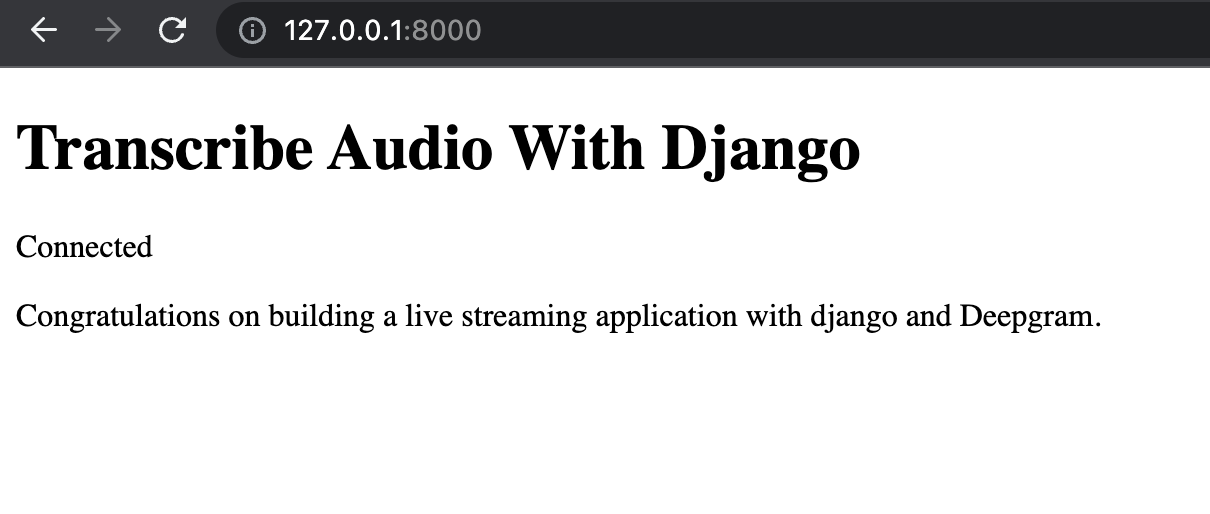
Congratulations on building a real-time transcription project with Django and Deepgram. You can find the code here with instructions on how to run the project. If you have any questions, please feel free to reach out to us on Twitter at @DeepgramDevs.
If you have any feedback about this post, or anything else around Deepgram, we'd love to hear from you. Please let us know in our GitHub discussions .
More with these tags:
Share your feedback
Was this article useful or interesting to you?
Thank you!
We appreciate your response.





